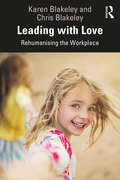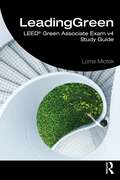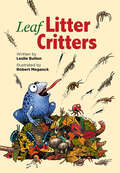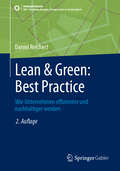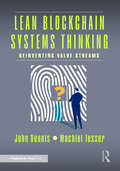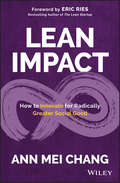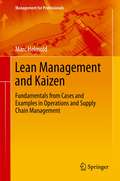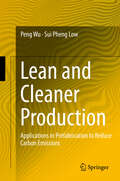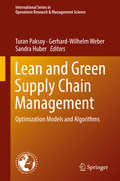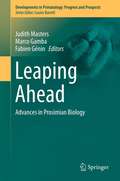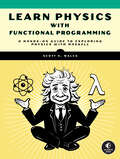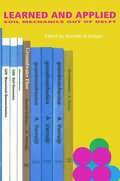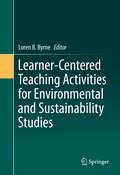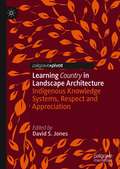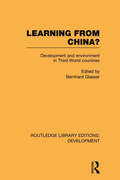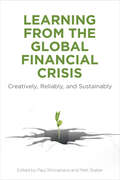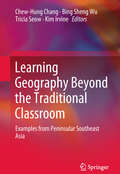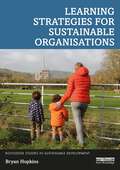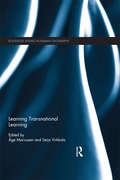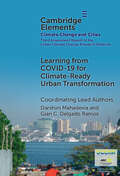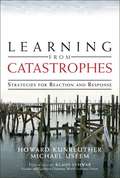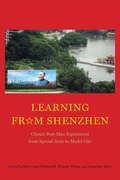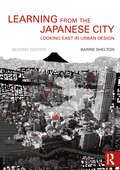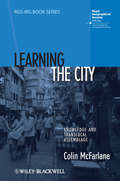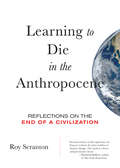- Table View
- List View
Leading with Love: Rehumanising the Workplace
by Karen Blakeley Chris BlakeleyAs business becomes more automated, power more concentrated, and the forces of competition and consumption seem to dominate our lives, we are in danger of losing what it is to be human. Work for many can be a soulless activity, creating feelings of disempowerment, alienation, and depression. Learning to lead with love is a counterforce to the instrumentalisation of the person. This book presents original research based on leaders who were nominated by their people for leading with love. It shows how they learned to lead with love for the benefit of themselves, their organisations, and their people. It shows that leading with love is something that is practised by leaders who are more emotionally, morally, and spiritually mature. Leading with love is a sign of psychological maturity, whilst leading with fear is a sign of hindered emotional and spiritual development. Based on this research, this book presents a simple framework to help leaders who wish to develop their psychological maturity and apply practices which will enable them to successfully lead with love.
LeadingGreen: LEED® Green Associate Exam v4 Study Guide
by Lorne MlotekLeadingGreen: LEED® Green Associate Exam v4 Study Guide brings together a concise introduction to the core concepts behind the LEED green building rating system with efficient, effective test preparation for the LEED® Green Associate Exam. The guide provides an essential foundation in principles of sustainable design and construction for students and professionals in the areas of architecture, engineering, construction, real estate development, urban planning, and environmental policy. If you are interested in passing the LEED® Green Associate Exam, this is the right place to start. The background, objectives, and evolution of green building standards – as well as what actually goes into a LEED building – are covered in a clear and straightforward manner. Tailored to precise exam expectations, the guide breaks down the key LEED categories one credit at a time. Drawing upon the author’s extensive experience as a LEED educator for universities and professional firms around the world, the guide includes proven tips and tricks that have helped over 10,000 people pass the Green Associate Exam. An ideal resource for self-study, LeadingGreen: LEED® Green Associate Exam v4 Study Guide will benefit readers from all built environment professions in which LEED credentials are an asset.
Leaf Litter Critters
by Leslie BulionTake a poetic tour through the duff and get the dirt on the tiny, fascinating critters that live there.For all the kids who can't resist turning over a rock, science poetry maven Leslie Bulion presents nineteen lively ecological poems in a variety of verse forms about the "brown food web" and the creatures that live there—from bacteria and rove beetles to mushrooms and millipedes, and all of the other busy recyclers in between. Illustrator Robert Meganck adds to the fun with humorous and vivid, yet scientifically detailed, artwork. Science notes run throughout for added context, and thorough back matter includes a glossary, poetry notes, hands-on investigations, and other resources for cross-curricular learning.
Lean & Green: Wie Unternehmen effizienter und nachhaltiger werden (SDG - Forschung, Konzepte, Lösungsansätze zur Nachhaltigkeit)
by Daniel ReichertDieses Buch präsentiert Erfolgsrezepte führender europäischer Unternehmen, die durch Lean-Management und Nachhaltigkeitsstrategien Wettbewerbsvorteile erzielen. Die vorgestellten Unternehmen, Teilnehmer des Lean & Green Management Awards, demonstrieren, wie Effizienzsteigerung und ökologische sowie soziale Verantwortung Hand in Hand gehen können.In Zeiten wachsender Unsicherheiten, geprägt durch geopolitische Spannungen, regulatorische Anforderungen und Rohstoffknappheit, wird nachhaltige Wertschöpfung zum entscheidenden Erfolgsfaktor. Unternehmen, die Ressourceneffizienz systematisch steigern, senken nicht nur Kosten, sondern erhöhen ihre Widerstandsfähigkeit und Zukunftsfähigkeit.Das Konzept Lean & Green kombiniert schlanke, effiziente Prozesse mit Umwelt- und Nachhaltigkeitsaspekten, um Nachhaltigkeit messbar und operativ wirksam zu machen. Der Autor zeigt, wie Unternehmen Lean-Methoden gezielt für mehr Nachhaltigkeit nutzen können, um wirtschaftlichen Erfolg und ökologische Verantwortung zu vereinen. Praktische Anleitungen und Best-Practice-Beispiele bieten wertvolle Einblicke für Unternehmen, die ihre Wettbewerbsfähigkeit langfristig sichern wollen.
Lean Blockchain Systems Thinking: Reinventing Value Streams
by John Dennis Machiel TesserThis book brilliantly illustrates how blockchain and Web3 are revolutionizing value exchange in society. Blockchain technology sets new standards for transparency, provenance, and traceability, benefiting every stakeholder across the value chain in an interoperable manner. The technology fundamentally transforms industries, verticals, and functions within organizations, enabling decentralized identity, asset tokenization, governance, and enhanced privacy. This book offers a deep yet accessible guide to navigating this new paradigm.—Alejandro Acuña Rodríguez, Blockchain Infrastructure Specialist, CrossmintLean Thinking has its roots in ideas developed for process improvement in the 1900s. Systems Thinking was discussed as far back as the 1950s. Blockchain technology is based on work that started in the 1990s and was implemented soon after Satoshi Nakamoto published his Bitcoin whitepaper in 2009. Together, these three components—Lean, Blockchain, and Systems Thinking—provide a revolutionary force in process management efficiency and effectiveness.This book provides a perspective on the advantages of blockchain technology that is rarely covered in business books as well as specialist blockchain-related content. The focus has been the use of Cryptocurrencies as a store of financial value and as an instrument of speculation, like the stock market. This book shows that blockchain, together with Lean and Systems Thinking can provide multiple advantages for societies and the environment. It can be used effectively to meet sustainable development goals (SDGs).Readers will appreciate that blockchain within Lean practices and Systems Thinking opens opportunities for fundamental organizational transformation, improved strategic decision-making, increased interoperability, and a fairer, more sustainable, and less wasteful world. This book clarifies how the integration of blockchain technology as an organizational concept integrates Lean principles and Systems Thinking. This brings a transformative shift in process design, increasing productivity while minimizing waste across sectors such as industry, public services, governance, supply chains, and social frameworks.
Lean Impact: How to Innovate for Radically Greater Social Good
by Ann Mei ChangDespite enormous investments of time and money, are we making a dent on the social and environmental challenges of our time? What if we could exponentially increase our impact? Around the world, a new generation is looking beyond greater profits, for meaningful purpose. But, unlike business, few social interventions have achieved significant impact at scale. Inspired by the modern innovation practices, popularized by bestseller The Lean Startup, that have fueled technology breakthroughs touching every aspect of our lives, Lean Impact turns our attention to a new goal - radically greater social good. Social change is far more complicated than building a new app. It requires more listening, more care, and more stakeholders. To make a lasting difference, solutions must be embraced by beneficiaries, address root causes, and include an engine that can accelerate growth to reach the scale of the need. Lean Impact offers bold ideas to reach audacious goals through customer insight, rapid experimentation and iteration, and a relentless pursuit of impact. Ann Mei Chang brings a unique perspective from across sectors, from her years as a tech executive in Silicon Valley to her most recent experience as the Chief Innovation Officer at USAID. She vividly illustrates the book with real stories from interviews with over 200 organizations across the US and around the world. Whether you are a nonprofit, social enterprise, triple bottom line company, foundation, government agency, philanthropist, impact investor, or simply donate your time and money, Lean Impact is an essential guide to maximizing social impact and scale.
Lean Management and Kaizen: Fundamentals from Cases and Examples in Operations and Supply Chain Management (Management for Professionals)
by Marc HelmoldThe book provides a holistic and practical approach to lean management throughout the business value chain. The lean management framework and tools demonstrate the optimal design and use of methods, tools and principles for companies and organisations. The author describes comprehensively how lean management enables companies to concentrate on value-adding activities and processes to achieve a long-term, sustainable competitive advantage. A wealth of best practices, industry examples and case studies are used to reveal the diversity and opportunities of lean management methodologies, methods and principles. Moreover, the book shows how lean management principles are ultimately applied in industries like automotive, healthcare, education and services industries.
Lean and Cleaner Production
by Sui Pheng Low Peng WuThis book explains how in moving towards Cleaner Production, the Lean Production Philosophy can be applied to reduce carbon emissions in prefabrication - one major source of the Greenhouse Gas (GHG) emissions which contribute to global climate change. This book examines theories and principles in the Lean Production Philosophy to develop situation-based carbon reduction strategies for precast concrete manufacturers and contractors in terms of Site layout, Supply Chain, Production, Stocks and Installation Management. It presents the empirical findings of surveys and case studies with managers and professionals working for precasters and contractors in Singapore, findings which provide good practical guidance for precast concrete manufacturers and contractors to achieve low carbon emissions and to perform better in many sustainability-based rating systems, such as the Singapore Green Labelling Scheme and the Building and Construction Authority (BCA) Green Mark Scheme.
Lean and Green Supply Chain Management: Optimization Models and Algorithms (International Series in Operations Research & Management Science #273)
by Gerhard-Wilhelm Weber Turan Paksoy Sandra HuberThis book presents the latest developments in optimization and optimal control models; exact, approximate and hybrid methods; and their applications in lean and green supply chains. It examines supply chain network design and modeling, closed loop supply chains, and lean, green, resilient and agile or responsive networks, and also discusses corporate social responsibility and occupational health and safety. It particularly focuses on supply chain management under uncertainty – employing stochastic or nonlinear modeling, simulation based studies and optimization – multi-criteria decision-making and applications of fuzzy set theory, and covers various aspects of supply chain management such as risk management, supplier selection or the design of automated warehouses. Lastly, using experimental applications and practical case studies, it shows the impact of lean and green applications on vehicle/fleet management and operations management.
Leaping Ahead
by Fabien Génin Russell Tuttle Marco Gamba Judith MastersLeaping Ahead: Advances in Prosimian Biology presents a summary of the state of prosimian biology as we move into the second decade of the 21st century. The book covers a wide range of topics, from assessments of diversity and evolutionary scenarios, through ecophysiology, cognition, behavioral and sensory ecology, to the conservation and survival prospects of this extraordinary and diverse group of mammals. The collection was inspired by an international conference in Ithala, KwaZulu-Natal, South Africa in 2007, where prosimian biologists gathered from Canada, Finland, France, Germany, India, Italy, Japan, Madagascar, South Africa, Tanzania, the United Kingdom, and the United States of America. The meeting reverberated with the passion prosimian researchers feel for their study subjects and with their deep concern for the future of prosimians in the face of ongoing habitat destruction and the burgeoning threat of bushmeat hunting. Chapters for this volume were contributed by researchers from across the globe; they attest to the diversity, vibrancy and rapid growth of prosimian biology, and to the intellectual advances that have revolutionized this field in recent years. Since its earliest beginnings, prosimian research and its resultant literature have had a strong francophone component, and researchers in many prosimian habitat countries are more comfortable reading and writing in French rather than English. French summaries of all chapters have been included. The volume is targeted at researchers, both those entering the field and established scientists, who have an interest in the biology of primates and small mammals. It is also aimed at conservation biologists seeking a deeper understanding of the faunas and conservation developments in Africa, Madagascar and Southeast Asia, and anyone who has an interest in discovering the true diversity of our order, the Primates.
Learn Physics with Functional Programming: A Hands-on Guide to Exploring Physics with Haskell
by Scott N. WalckDeepen your understanding of physics by learning to use the Haskell functional programming language.Learn Physics with Functional Programming is your key to unlocking the mysteries of theoretical physics by coding the underlying math in Haskell.You&’ll use Haskell&’s type system to check that your code makes sense as you deepen your understanding of Newtonian mechanics and electromagnetic theory, including how to describe and calculate electric and magnetic fields.As you work your way through the book&’s numerous examples and exercises, you&’ll learn how to:Encode vectors, derivatives, integrals, scalar fields, vector fields, and differential equationsExpress fundamental physical principles using the logic of Haskell&’s type system to clarify Newton&’s second law, Coulomb&’s law, the Biot-Savart law, and the Maxwell equationsUse higher-order functions to express numerical integration and approximation methods, such as the Euler method and the finite-difference time-domain (FDTD) methodCreate graphs, models, and animations of physical scenarios like colliding billiard balls, waves in a guitar string, and a proton in a magnetic fieldWhether you&’re using this book as a core textbook for a computational physics course or for self-study, Learn Physics with Functional Programming will teach you how to use the power of functional programming to explore the beautiful ideas of theoretical physics.
Learned and Applied Soil Mechanics: A tribute to Dr Arnold Verruijt, TUD
by Frans B.J. Barends Paola M.P.C. SteijgerA tribute to Professor Dr Arnold Verruijt, on the occasion of his retirement as professor in soil mechanics at the Technical University of Delft, this book is divided into five chapters covering: groundwater flow, consolidation, numerical methods, geodynamics and geostatics.
Learner-Centered Teaching Activities for Environmental and Sustainability Studies
by Loren B. ByrneLearner-centered teaching is apedagogical approach that emphasizes the roles of students as participants inand drivers of their own learning. Learner-centered teaching activities gobeyond traditional lecturing by helping students construct their ownunderstanding of information, develop skills via hands-on engagement, andencourage personal reflection through metacognitive tasks. In addition,learner-centered classroom approaches may challenge students' preconceivednotions and expand their thinking by confronting them with thought-provokingstatements, tasks or scenarios that cause them to pay closer attention andcognitively "see" a topic from new perspectives. Many types of pedagogy fallunder the umbrella of learner-centered teaching including laboratory work,group discussions, service and project-based learning, and student-ledresearch, among others. Unfortunately, it is often not possible to use some ofthese valuable methods in all course situations given constraints of money,space, instructor expertise, class-meeting and instructor preparation time, andthe availability of prepared lesson plans and material. Thus, a major challengefor many instructors is how to integrate learner-centered activities widelyinto their courses. The broad goal of this volume is to helpadvance environmental education practices that help increase students'environmental literacy. Having a diverse collection of learner-centeredteaching activities is especially useful for helping students develop theirenvironmental literacy because such approaches can help them connect morepersonally with the material thus increasing the chances for altering theaffective and behavioral dimensions of their environmental literacy. Thisvolume differentiates itself from others by providing a unique and diversecollection of classroom activities that can help students develop theirknowledge, skills and personal views about many contemporary environmental andsustainability issues.
Learning Country in Landscape Architecture: Indigenous Knowledge Systems, Respect and Appreciation
by David S. JonesThis book strategically focuses upon the feasibility of positioning Indigenous Knowledge Systems into tertiary built environment education and research in Australia. Australian tertiary education has little engaged with Indigenous peoples and their Indigenous Knowledge Systems, and the respectful translation of their Indigenous Knowledge Systems into tertiary education learning. In contrast, while there has been a dearth of discussion and research on this topic pertaining to the tertiary sector, the secondary school sector has passionately pursued this topic. There is an uneasiness by the tertiary sector to engage in this realm, overwhelmed already by the imperatives of the Commonwealth’s ‘Closing the Gap’ initiative to advance Aboriginal and Torres Strait Islander tertiary education successes and appointments of Indigenous academics. As a consequence, the teaching of Indigenous Knowledge Systems relevant to professional disciplines, particularly landscape architecture where it is most apt, is overlooked and similarly little addressed in the relevant professional institute education accreditation standards.
Learning From China?: Development and Environment in Third World Countries (Routledge Library Editions: Development)
by Bernhard GlaeserFirst published in 1987, this volume was written to shed some light upon the nature and environmental consequences and wider relevance of development strategies in the Peoples’ Republic of China. It covers industrialisation, food production, energy use and landscape and settlement planning. The Chinese "autocentred" strategy is assessed from both the developmental and the environmental viewpoints. Decision-making processes and the opportunities to implement environmental policy in other parts of the developing world are analysed and the volume concludes with the view that benefits to other countries are likely to arise out of increased co-operation and exchange with China, although the Chinese model is by no means a panacea. All students and researchers interested in either environmental or developmental issues will find this book to be a substantial and enlightening contribution to literature.
Learning From the Global Financial Crisis: Creatively, Reliably, and Sustainably (High Reliability and Crisis Management)
by Paul Shrivastava and Matt StatlerThis book is motivated by the simple hope that the cloud of the global financial crisis may yet have a silver lining—that political leaders, economists, and management scholars might seize this opportunity to reflect critically on the assumptions, practices, and infrastructures that have precipitated the crisis and to imagine and create new forms of organization that sustainably enhance the well-being of global stakeholders. The contributors suggest that aesthetic management, high reliability and crisis management, and sustainability science have much to contribute to the resolution of the collapse that we've witnessed, and to providing enduring lessons for how to structure the institutions of the future. Learning From the Global Financial Crisis devotes a section to each of these areas, offering full-length chapters which explore key issues in depth, as well as shorter commentaries that focus on practical considerations. The chapters progress from micro-level issues that pertain to individuals and teams who act creatively; to the meso-level issues that pertain to the structures, practices, and processes; to the macro-level issues that pertain to the interdependent, ecological systems. Together, the contributions emphasize the importance of developing holistic responses to the financial crisis. The result is a volume that casts new light on traditional economic and managerial theories and policies and provides fresh ideas to a new generation of scholars and practitioners.
Learning Geography Beyond the Traditional Classroom: Examples From Peninsular Southeast Asia
by Chew-Hung Chang Bing Sheng Wu Tricia Seow Kim IrvineThis book provides a collection of critical pieces that support the idea that good teaching and learning of geography in fieldwork and using technology should consider the dimensions of curriculum design, instructional design and resource provision, as well as assessment for such learning activities. Further, it clearly describes the thinking, experiences and critical comments concerning two broad areas of learning outside the traditional classroom – in the field and with technology.
Learning Strategies for Sustainable Organisations (Routledge Studies in Sustainable Development)
by Bryan HopkinsLearning Strategies for Sustainable Organisations explores sustainability in the context of organisational practice and its implications for learning. Based on a systems thinking approach, it provides a thorough grounding in the principles of systems thinking and tools that can be used to help implement sustainability-focused learning strategies. Increasingly, organisations are recognising the importance of adapting their practices to become more sustainable. Drawing on the Agenda 2030 Sustainable Development Goals as a framework, new knowledge, skills and attitudes are required to help provide products and services that align with changing social and ecological environments and better serve the communities of which they are a part. This book is a practical guide showing how to facilitate sustainability learning and development within organisations, explaining how to identify gaps in current practice, take into account different contexts and perspectives about what sustainability means, and evaluate results following implementation. Learning resources include chapter summaries, illustrations, reflection points, mind maps and further reading. Written by an independent performance and learning consultant with extensive experience working with international organisations, this book provides a necessary toolkit for human resource development directors, training managers, chief sustainability officers and management consultants specialising in sustainable development.
Learning Transnational Learning (Routledge Studies in Human Geography)
by Åge Mariussen Seija VirkkalaSystems of innovation that are conducted within national borders can preserve inefficient solutions and prevent development. This has led to a feeling that transnational learning strategies are more and more desirable. In practice, the field of transnational learning has been dominated by various policy-making institutions, such as the OECD and European Union, working through different types of policy instruments and programs such as structural funds, open methods of coordination, as well as international research institutions and networks set up by cooperating national governments working on comparative analysis, benchmarking and indicators. This book lays out a set of methods which can further enhance the experience of transnational learning, starting from the sociological ideas promoted by Charles Sabel of learning through monitoring, and by Marie Laure Djelic and others of the “translation” of experiences between different countries. Case studies and examples are collected from three fields: industrial development, tourism and local government.
Learning from COVID-19 for Climate-Ready Urban Transformation (Elements in Climate Change and Cities)
by Darshini Mahadevia Gian C. Delgado-Ramos Janice Barnes Joan Fitzgerald Miho Kamei Kevin LanzaCities have suffered from three years of the COVID-19 pandemic and are increasingly experiencing exacerbated heatwaves, floods, and droughts due to climate change. Going forward, cities need to address both climate and public health crises effectively while reducing poverty and inequity, often in the context of economic pressure and declining levels of trust in government. The COVID-19 pandemic has revealed gaps in city readiness for simultaneous responses to pandemics and climate change, particularly in the Global South. However, these concurrent challenges to cities present an opportunity to reformulate current urbanization patterns and the economies and dynamics they enable. This Element focuses on understanding COVID-19's impact on city systems related to climate change mitigation and adaptation, and vice versa, in terms of warnings, lessons learned, and calls to action. This title is also available as open access on Cambridge Core.
Learning from Catastrophes: Strategies for Reaction and Response
by Michael Useem Howard KunreutherBreakthrough, business-focused techniques for managing the growing risks of catastrophe, from world's leading experts--Indispensable 'extreme risks' guidance for decision-makers in a world that is becoming increasingly unstable. -Powerful assessment models, decision-making techniques, and best practices for building resilience into any organization, public or private. -Edited by the leading experts who recently introduced influential new techniques for managing extreme risks at the World Economic Forum. Events ranging from Hurricane Katrina to the global economic crisis have taught businesspeople an unforgettable lesson: if you don't plan for 'extreme risk,' you endanger your organization's very survival. But how can you plan for events that go far beyond anything that occurs in normal day-to-day business? In Learning from Catastrophes, two renowned experts present the first comprehensive strategic framework for assessing, responding to, and managing extreme risk. Howard Kunreuther and Michael Useem build on their own breakthrough work on mitigating natural disasters, extending it to the challenges faced by real-world enterprises. Along with the contributions of leading experts in risk management, heuristics, and disaster recovery, they identify the behavioral biases and faulty heuristics that mislead decision makers about the likelihood of catastrophe. They go on to identify the hidden links associated with extreme risks, and present techniques for systematically building greater resilience into the organization. The global best-seller The Black Swan told executives that 'once in a lifetime' events are far more common and dangerous than they ever realized. Learning from Catastrophe shows them exactly what to do about it.
Learning from Shenzhen: China’s Post-Mao Experiment from Special Zone to Model City
by Jonathan Bach Mary Ann O'Donnell Winnie WongThis multidisciplinary volume, the first of its kind, presents an account of China’s contemporary transformation via one of its most important yet overlooked cities: Shenzhen, located just north of Hong Kong. In recent decades, Shenzhen has transformed from an experimental site for economic reform into a dominant city at the crossroads of the global economy. The first of China’s special economic zones, Shenzhen is today a UNESCO City of Design and the hub of China’s emerging technology industries. Bringing China studies into dialogue with urban studies, the contributors explore how the post-Mao Chinese appropriation of capitalist logic led to a dramatic remodeling of the Chinese city and collective life in China today. These essays show how urban villages and informal institutions enabled social transformation through cases of public health, labor, architecture, gender, politics, education, and more. Offering scholars and general readers alike an unprecedented look at one of the world’s most dynamic metropolises, this collective history uses the urban case study to explore critical problems and possibilities relevant for modern-day China and beyond.
Learning from the Japanese City: Looking East in Urban Design (Planning, History and Environment Series)
by Barrie SheltonJapanese cities are amongst the most intriguing and confounding anywhere. Their structures, patterns of building and broader visual characteristics defy conventional urban design theories, and the book explores why this is so. Like its cities, Japan’s written language is recognized as one of the most complicated, and the book is unique in revealing how the two are closely related. Set perceptively against a sweep of ideas drawn from history, geography, science, cultural and design theory, Learning from the Japanese City is a highly original exploration of contemporary urbanism that crosses disciplines, scales, time and space. This is a thoroughly revised and much extended version of a book that drew extensive praise in its first edition. Most parts have stood the test of time and remain. A few are replaced or removed; about a hundred figures appear for the first time. Most important is an entirely new (sixth) section. This brings together many of the urban characteristics, otherwise encountered in fragments through the book, in one walkable district of what is arguably Japan’s most convenient metropolis, Nagoya. The interplay between culture, built form and cities remains at the heart of this highly readable book, while a change in subtitle to Looking East in Urban Design reflects increased emphasis on real places and design implications.
Learning the City: Knowledge and Translocal Assemblage (RGS-IBG Book Series #101)
by Colin McFarlaneLearning the City: Translocal Assemblage and Urban Politics critically examines the relationship between knowledge, learning, and urban politics, arguing both for the centrality of learning for political strategies and developing a progressive international urbanism. Presents a distinct approach to conceptualising the city through the lens of urban learning Integrates fieldwork conducted in Mumbai's informal settlements with debates on urban policy, political economy, and development Considers how knowledge and learning are conceived and created in cities Addresses the way knowledge travels and opportunities for learning about urbanism between North and South
Learning to Die in the Anthropocene
by Roy Scranton"In Learning to Die in the Anthropocene, Roy Scranton draws on his experiences in Iraq to confront the grim realities of climate change. The result is a fierce and provocative book."--Elizabeth Kolbert, Pulitzer Prize-winning author of The Sixth Extinction: An Unnatural History"Roy Scranton lucidly articulates the depth of the climate crisis with an honesty that is all too rare, then calls for a reimagined humanism that will help us meet our stormy future with as much decency as we can muster. While I don't share his conclusions about the potential for social movements to drive ambitious mitigation, this is a wise and important challenge from an elegant writer and original thinker. A critical intervention."--Naomi Klein, author of This Changes Everything: Capitalism vs. the Climate Coming home from the war in Iraq, US Army private Roy Scranton thought he'd left the world of strife behind. Then he watched as new calamities struck America, heralding a threat far more dangerous than ISIS or Al Qaeda: Hurricane Katrina, Superstorm Sandy, megadrought--the shock and awe of global warming.Our world is changing. Rising seas, spiking temperatures, and extreme weather imperil global infrastructure, crops, and water supplies. Conflict, famine, plagues, and riots menace from every quarter. From war-stricken Baghdad to the melting Arctic, human-caused climate change poses a danger not only to political and economic stability, but to civilization itself . . . and to what it means to be human. Our greatest enemy, it turns out, is ourselves. The warmer, wetter, more chaotic world we now live in--the Anthropocene--demands a radical new vision of human life.In this bracing response to climate change, Roy Scranton combines memoir, reportage, philosophy, and Zen wisdom to explore what it means to be human in a rapidly evolving world, taking readers on a journey through street protests, the latest findings of earth scientists, a historic UN summit, millennia of geological history, and the persistent vitality of ancient literature. Expanding on his influential New York Times essay (the #1 most-emailed article the day it appeared, and selected for Best American Science and Nature Writing 2014), Scranton responds to the existential problem of global warming by arguing that in order to survive, we must come to terms with our mortality.Plato argued that to philosophize is to learn to die. If that's true, says Scranton, then we have entered humanity's most philosophical age--for this is precisely the problem of the Anthropocene. The trouble now is that we must learn to die not as individuals, but as a civilization.A war veteran, journalist, author, and Princeton PhD candidate, Roy Scranton has published in the New York Times, Wall Street Journal, Rolling Stone, Boston Review, and Theory and Event, and has been interviewed on NPR's Fresh Air, among other media.imes. This compressed, essential text offers both uncomfortable truths and unexpected joy."--McKenzie Wark, author of Molecular Red: Theory for the Anthropocene
